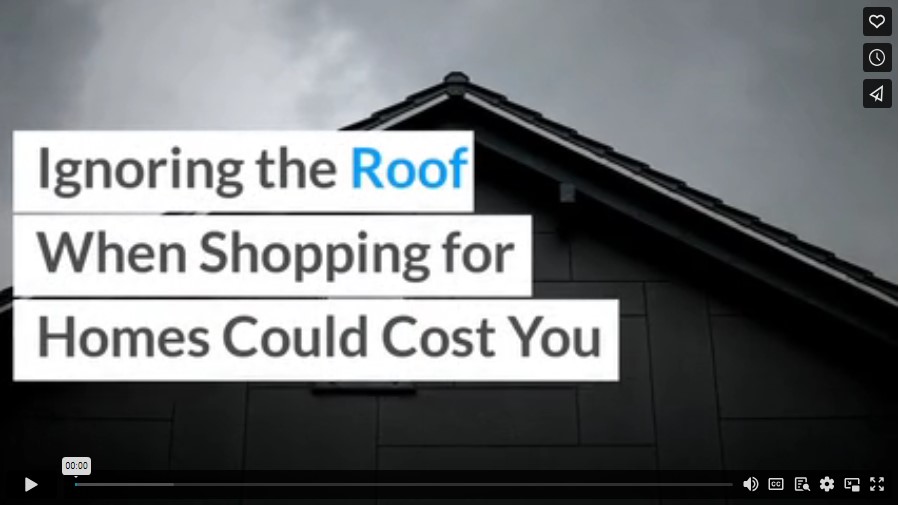We’ve all heard the real estate adage, it’s all about location, location, location. But if you ignore roof, roof, roof, you could be buying years worth of headaches, leaks, and expenses.
We all have lists of must haves in a new home, such as a large yard, walk-in closets, a great master bath, or space to entertain guests. Too often, though, home buyers look at kitchen cabinets and closet space but overlook structural and foundational features. If you forget to look up before writing an offer, you could be in for a nasty surprise.
It’s vital that you check the condition of any potential home’s roof before you purchase it. While your home inspector may be able to spot potential problems with the roof, it is a great idea to look for problems before you write your offer.
Not sure what to look for? Answering these seven questions about your roof will help you uncover potential roofing problems.
Is it smooth?
Stand back and look at the roof from several angles. The roofing material should appear flat and even. If there are bumps, waves, or uneven sections, there is likely a problem. Shingles should lay flat against the roof. Bulges or curling edges could be a sign of a problem. Likewise missing roofing tiles or tiles that have shifted out of place need to be addressed. The roof should have a smooth, uniform appearance.
Does it shine?
One surprising sign of trouble is shine. If the sunlight hitting your roof gives it a shiny appearance, that may be the light reflecting off fiberglass fibers in the shingles. This is an indication that the roof is wearing out. When house shopping, you want the countertops to glisten and the hardwood floors to gleam, but you don’t want the roof to shine.
How old is it?
Ask about the roof’s age and whether there is a warranty that will transfer. Most roof materials have an expected lifespan. Find out the expected life of the roof product on your potential purchase. If a roof replacement is likely to be necessary in the near future, make sure that you leave room in your budget for that.
What type of roof is it?
Roofing materials can be wood, composite, metal, clay, or even rubber. Some of these will last much longer than others. Knowing the roof’s composition will help you gauge how long it is likely to last after you buy the house as well as how much it will cost to repair or replace it when the time comes.
Is it vented?
Even a brand-new, high-quality roof is likely to have problems if it isn’t correctly ventilated. Improper or insufficient ventilation can cause mold, ice dams in winter, and higher utility bills. Your home needs to breathe, letting out hot, moist air, via the roof vents. Check the roof for visible vents.
Does it drain well?
Your house safely sheds water via gutters, downspouts, and drainage pipes. Make sure these are in place. Look for areas where the gutter may have pulled away from the roofline. If there are long, thin depressions in the soil below the gutters, that’s a sign they often overflow. These signs could mean they just need a good cleaning to remove a blockage, but it could also speak to problems with the drainage system.
Check to ensure the downspouts don’t release a large volume of water directly to the ground. Once it reaches the ground, water should flow away from the foundation. Too much water up next to the house can erode the structure of your home or lead to water intrusion or mold.
Are there signs of water damage?
One of the best ways to check the roof is from the inside of the house. Wet or dark spots on ceilings or walls often mean the roof is no longer watertight. Leaks can travel through ceilings and walls, so the location of a water spot is not a good indicator of the leak’s location but it is a sign there’s a problem somewhere.
When in doubt, get a thorough roof inspection to determine whether there is a leak, how severe it is, and how much it will cost to repair. If ignored, leaks can cause mold, damage to walls and furniture, and headaches for new homeowners.
Your home is likely your most significant investment. That makes it even more critical to get it right. Of course you want to pay attention to the floor plan, the location, and the size of the bedrooms, but be sure to check the roof as well. If you have concerns, consulting a residential roofing contractor before writing an offer or closing escrow can help you feel confident that the roof on your dream home won’t become a nightmare.
Infographic
Everyone has a list of amenities they would want to have in a new home. Too often, though, buyers of homes pay more interest to kitchen and closet space than structural and underlying attributes. Before acquiring, you must check the roof of any prospective property. Uncertain of what to look for? Spot the potential problems with your roof by asking yourself these seven questions.

Video

